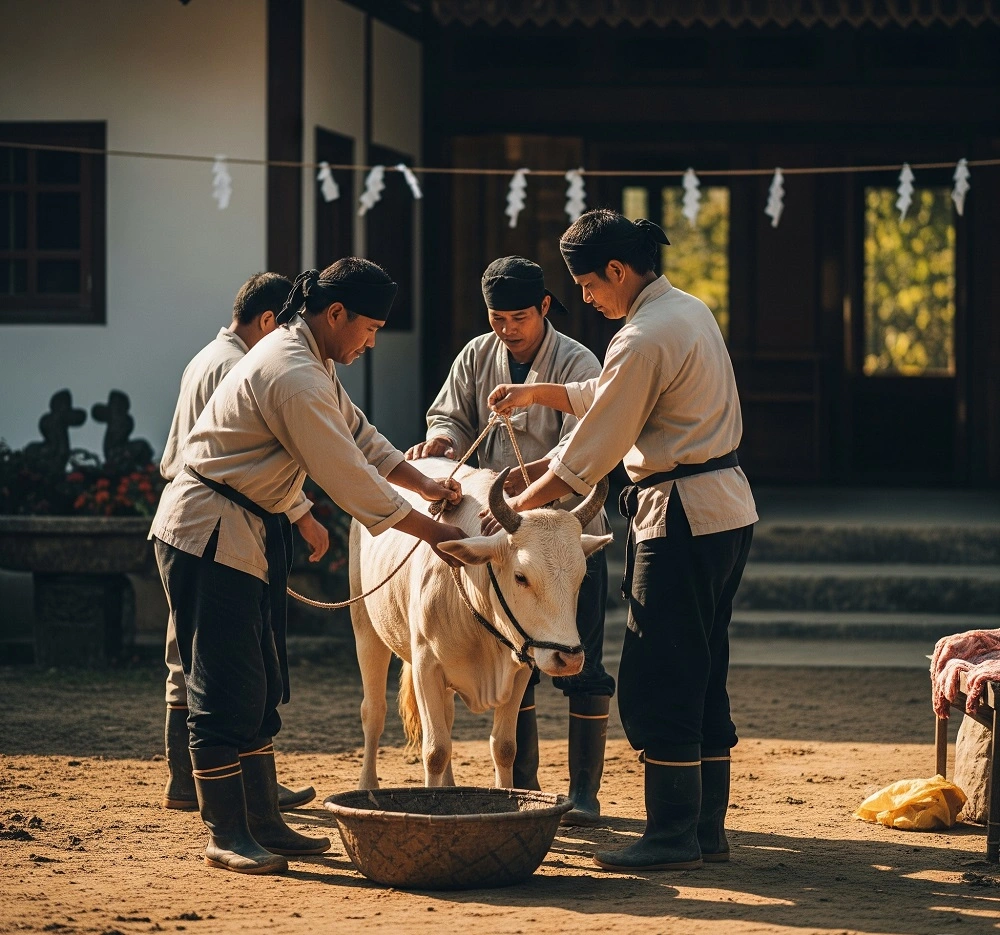Eid al-Adha: Exploring the Virtues and Halal Ethics of Qurban for Blessings
Understand the profound meaning of Qurban worship during Eid al-Adha, from its spiritual value and social impact to a guide on ethical and halal animal slaughter according to Islamic law.

Eid al-Adha, also known as the Festival of Sacrifice, is one of the greatest celebrations in Islam, observed annually on the 10th of Dzulhijjah. More than just a holiday, Eid al-Adha is a sacred moment filled with messages of obedience, sacrifice, and care for others. At the heart of this celebration is the Qurban ritual, the slaughter of livestock whose meat is then distributed to those in need.
This article will take you on a journey to understand the true meaning of the virtues of Qurban, discussing how this worship holds deep spiritual value for its performer and brings extensive social impact to society. Furthermore, we will thoroughly explore the ethics and procedures for halal and humane Qurban animal slaughter, in accordance with Islamic law, to ensure a perfect and blessed worship.
I. The Virtues of Qurban: Spiritual Foundation and Social Bridge
Performing Qurban on Eid al-Adha is not merely an annual tradition; it’s a religious command with multifaceted benefits. It reflects a servant’s obedience to Allah SWT and a tangible act of care for fellow human beings.
A. Spiritual Dimension: Drawing Closer to the Divine
The most significant virtue of Qurban lies in its spiritual dimension. This worship is the embodiment of a Muslim’s total submission to Allah SWT’s command, emulating the grand story of Prophet Ibrahim (Abraham) AS, who was ready to sacrifice his son, Prophet Ismail (Ishmael) AS, upon His command. This narrative teaches profound lessons about true faith and absolute surrender.
- Increased Piety and Sincerity: Performing Qurban trains the soul to be more sincere and submissive to the Divine Will. It’s a test of faith that erodes excessive love for worldly possessions, replacing it with the hope for Qurban rewards and Allah’s pleasure alone. Every drop of blood from the sacrificial animal is, in essence, a manifestation of pure intent.
- Atonement for Sins and Multiplied Rewards: Prophet Muhammad (PBUH) said, “There is no deed more beloved to Allah on the Day of Sacrifice (Eid al-Adha) than the shedding of blood (slaughtering the sacrifice). Indeed, it (the sacrificial animal) will come on the Day of Judgment with its horns, fur, and hooves. And verily, its blood reaches Allah before it falls to the ground. So rejoice in it.” (HR. Tirmidhi and Ibn Majah). This Hadith emphasizes the immense Qurban rewards promised, believed even to atone for sins.
- A Grand Expression of Gratitude: For a Muslim blessed with abundant sustenance, performing Qurban is one of the best forms of gratitude. By sacrificing a portion of beloved possessions, one shows thankfulness for all blessings from Allah, while also sharing joy with others.
- Reviving the Sunnah of Prophet Ibrahim (AS): Performing the Qurban ritual is also a concrete effort to emulate the noble qualities of Prophet Ibrahim AS: his extraordinary patience, sincerity, and unwavering obedience. It’s a bridge connecting us to prophetic history.
B. Social Dimension: Building Solidarity and Community Justice
Beyond its spiritual value, the benefits of Qurban are also deeply felt in the social aspect of the community. The philosophy behind the distribution of Qurban meat is to ensure that the joy of Eid al-Adha can be experienced by all segments of society, especially the less fortunate.
- Strengthening Bonds of Brotherhood: The Qurban process, from procuring animals to slaughtering and distributing meat, often involves the collaboration of committees, volunteers, and community members. This is a very effective moment for strengthening social ties (ukhuwah Islamiyah) and fostering a spirit of mutual cooperation.
- Aiding the Nutrition of the Needy: This is one of the most tangible social impacts of Qurban. For many underprivileged families, Qurban meat might be their only opportunity to consume a significant amount of meat throughout the year. Thus, Qurban directly contributes to nutritional fulfillment and improves the quality of life for those in need.
- Reducing Social Disparity: Qurban worship effectively redistributes wealth from the affluent to the needy. This is a real manifestation of social justice in Islam, where wealth does not merely circulate among certain groups but is also enjoyed by all segments of society.
- Educating on Humanitarian Values: Through the practice of Qurban, communities, especially the younger generation, directly learn about the importance of sharing, caring for others, and empathy. This is an invaluable character education.
II. Halal and Humane Qurban Animal Slaughter: Ethics and Procedures
The halal status of Qurban is not just about intention, but also about the slaughtering process itself. Islam teaches the importance of Qurban animal slaughter ethics that uphold goodness and minimize animal suffering.
A. Respect for the Sacrificial Animal: Pre-Slaughter Ethics
Before the slaughtering of the Qurban animal begins, Islam teaches us to treat animals with ihsan (goodness and kindness), avoiding all forms of torture or neglect.
- Kind and Compassionate Treatment: Qurban animals must be handled calmly and gently. Provide a comfortable, clean place, and ensure the animals receive ample food and water.
- Minimizing Stress and Fear:
- Sharpening Knife Away from Animals: The knife must be as sharp as possible and sharpened out of sight of the animal to be slaughtered, or other animals.
- No Slaughtering in Front of Other Animals: Avoid slaughtering one animal in front of others to prevent fear.
- Calm Herding: Guide the animal to the slaughtering area calmly and slowly, without force.
- Health of the Qurban Animal: Ensure the Qurban animal is healthy, free from defects, and meets the Eid al-Adha Qurban requirements (age, type). Examination by animal health officials (usually from the local Livestock Agency) is highly recommended to ascertain the Qurban animal’s health and suitability.
B. Halal Slaughter Procedure According to Sharia
Once the pre-slaughter ethics are met, the focus shifts to the halal Qurban procedure that must be meticulously followed.
- The Slaughterer (Penyembelih): Must be a sane Muslim, understand the slaughter procedure according to Islamic law, and be skilled in using a sharp knife.
- Animal Preparation: Gently lay the animal on its left side, facing the Qibla. This position facilitates the slaughterer in cutting the animal’s neck from the right side.
- Very Sharp Knife: This is the key to humane Qurban animal slaughter. The knife must be extremely sharp to sever the vital vessels quickly and minimize pain.
- Recitation of Shahada and Intention: Before slaughtering, the slaughterer must recite “Bismillahirrahmanirrahim” (In the name of Allah, the Most Gracious, the Most Merciful), followed by “Allahu Akbar” (Allah is the Greatest), and state the intention to perform Qurban.
- Fast and Precise Slaughtering Motion:
- Single Stroke: The knife is placed beneath the animal’s neck and cut with a single, swift motion, severing the jugular veins (vena jugularis), esophagus (food pipe), and trachea (windpipe).
- Avoid Severing the Spinal Cord: Correct slaughter only severs the vessels in the neck without severing the spinal cord or the animal’s head entirely. This is crucial for ensuring complete blood drainage and a rapid death without suffering.
- Ensuring the Animal’s Demise: Allow the animal to struggle until it is completely lifeless and its blood has fully drained. Never begin the process of skinning or dismembering any part of the body before the animal is confirmed to have completely lost its life. This is to prevent the torture of the Qurban animal.
III. Overseeing Organizations and Real-World Impact of Qurban in Indonesia
In Indonesia, several institutions play a crucial role in overseeing the halal Qurban procedure and Qurban animal health, ensuring this worship runs smoothly and according to Islamic law.
A. Overseeing Bodies in Indonesia:
- Majelis Ulama Indonesia (MUI): The highest authority in issuing halal fatwas and certifications. MUI sets Sharia standards for Qurban animal slaughter and often conducts training for halal slaughterers (Juleha).
- Ministry of Religious Affairs of the Republic of Indonesia: Issues guidelines and appeals related to the syar’i and hygienic implementation of Qurban.
- Provincial/Regency/City Livestock and Animal Health Agencies (Dinas Peternakan dan Kesehatan Hewan): Responsible for ensuring the health of Qurban animals before slaughter through ante-mortem and post-mortem examinations.
- Mosque Prosperity Councils (DKM) and Qurban Committees: At the local level, they organize Qurban implementation according to guidelines and ensure the slaughter process is carried out by competent slaughterers.
B. Real-World Examples of Qurban’s Impact:
The impact of Qurban worship has been felt throughout Islamic history and continues in modern practices today.
- History: Since the time of Prophet Muhammad (PBUH), Qurban has been a pillar strengthening brotherhood and social care. The Prophet himself regularly performed Qurban and encouraged his followers, building a strong foundation of solidarity among Muslims.
- Contemporary Practice: Islamic philanthropic organizations, mosques, and humanitarian institutions play a crucial role.
- Collective Qurban Programs: Many institutions organize these programs, making it easier for individuals to participate.
- Distribution to Remote Areas: Qurban meat is often distributed to hard-to-reach areas, including disaster-stricken regions or Muslim minorities. For example, Qurban meat is distributed to remote areas of Papua or isolated regions in Kalimantan, where access to food and protein is often limited.
- Local Economic Empowerment: Purchasing sacrificial animals from local breeders also helps stimulate the economy at the grassroots level, positively impacting their welfare.
Conclusion: Qurban, a Perfect and Blessed Humanitarian Worship
Eid al-Adha and Qurban worship are clear proof that Islam not only teaches about the vertical relationship between humans and God (habluminallah) but also the horizontal relationship between humans and fellow beings (habluminannas). By performing Qurban, we not only fulfill religious commands and gain abundant Qurban rewards but also actively contribute to building a more just, caring, and prosperous society.
Understanding and implementing the ethics and procedures for halal Qurban animal slaughter is a crucial key to perfecting this worship. May our Qurban, performed ethically and humanely according to Islamic law, be accepted by Allah SWT and bring blessings to us all. Happy Eid al-Adha!






Comments